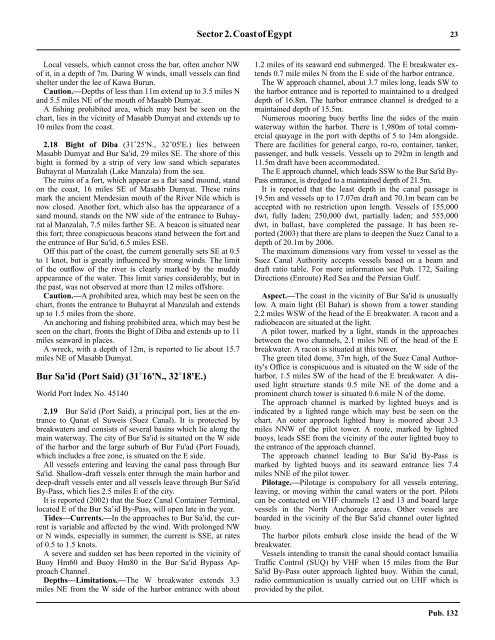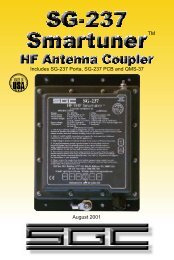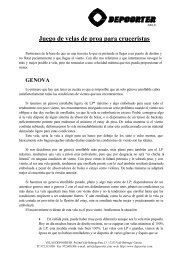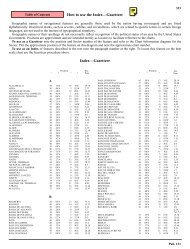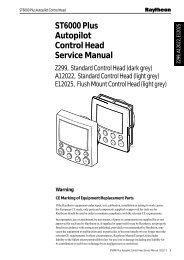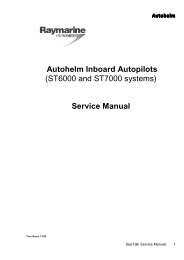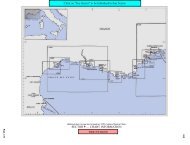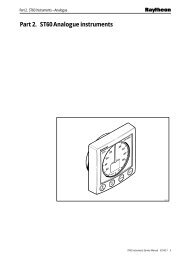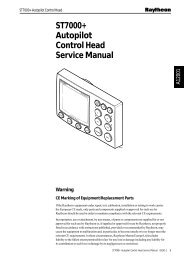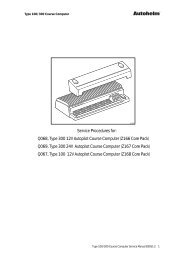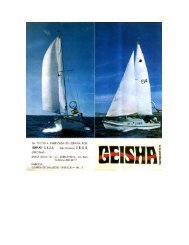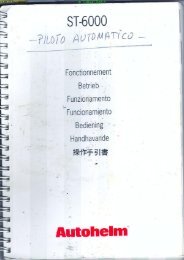22 Sector 2.CoastofEgyptfor many miles. Local craft are brought into the river by a localpilot who sounds out the channel shortly before their arrival.2.14 A main light (Rosetta) is shown from a structure standing onthe E bank, 4.5 miles SE of the entrance. A racon and a radiobeaconare situated at the light.2.14 Two disused forts, one on each side of the channel, stand 1mile within the river mouth. A minaret, 19m high, stands onthe E bank 2.2 miles W of the light, and a disused fort issituated close S of it, on the opposite bank. Two minarets, 36mand 46m high, stand in the town of Rashid (Rosetta), which issituated 2.5 miles S of the light.2.14 Dangerous wrecks lie about 4.5 miles and 7 miles NW of theriver mouth.2.14 Between Masabb Rashid and Masabb Dumyat, the bottomclose off the coast is formed of dark and heavy sand. It is quitedifferent from that lying W of Khalij Abu Qir, which is of alight color and formed by coral and shells.2.14 Caution.—During the summer, a large sardine fishing fleetmay be encountered off Masabb Rahid.2.14 Masabb Rashid is reported to be as much as 2 miles SE ofthe charted position. Mariners are advised to exercise extremecaution navigating in the vicinity.2.15 Cape Burullus (Brulos) (31˚35'N., 30˚59'E.), locatednearly midway between the entrances of the two branches ofthe River Nile, is the E entrance point of a small outlet from theextensive Buhayrat al Burullus (Lake Burullus). A conspicuouswater tower stands on this cape.2.15 The coast to the W of the cape is low and sandy while that tothe E consists of low sandhills. The outlet is navigable by shallowfishing craft with local knowledge.2.15 A main light (El Burullus) is shown from a structurestanding 5.5 miles E of the cape. A racon and a radiobeaconare situated at the light.2.15 A large hotel and several buildings are situated in the vicinityof the light.2.15 Several forts are situated along the coast to the E of the cape.They are mostly in ruins and have the appearance of sandmounds.Damietta (31˚28'N., 31˚45'E.)World Port Index No. 451512.16 Damietta, lying 5 miles W of Massab Dumyat, is adeep-water port which is connected to the River Nile by abarge canal with a dredged depth of 5m.2.16 Depths—Limitations.—The entrance channel, which is entered6 miles NNE of the breakwaters, is 250 to 300m wide andis dredged to a depth of 15m. The harbor has 14 main commercialberths. Four container berths, each 250m long, have adepth of 14.5m alongside; two bulk berths, each 300m long,have a depth of 14.5m alongside; and eight general cargoberths, each 200m long, have a depth of 12m alongside. Inaddition, there are two ro-ro berths and 700m of quayage, witha depth of 4.5m alongside.2.16 Bulk vessels up to 80,000 dwt, 250m in length, and 12.5mdraft can be accommodated. General cargo vessels are limitedto 11m draft.2.16 Aspect.—The harbor is protected by two breakwaters. Aprominent silo also stands on the E side of the harbor basin.The entrance channel is marked by lighted buoys and indicatedby a lighted range which may best be seen on the chart.2.16 Pilotage.—Pilotage is compulsory. Vessels should send anETA to the port authority 7 days and 24 hours in advance.Vessels should then contact the pilot station on VHF channel14 or 16 when within 6 or 7 miles of the breakwaters. Pilotswill generally board in the vicinity of the waiting area, about6.5 miles N of the harbor entrance.2.16 Regulations.—Mariners are advised that Traffic SeparationSchemes and associated Precautionary Areas in the approachesto Mina Dumyat and Bur Sa’id have been established by thegovernment of Egypt.2.16 Anchorage.—A designated Anchoring/Waiting Area, whichis best seen on the chart, has depths of 15 to 16m and is markedby a lighted buoy.2.16 Caution.—Damietta Banks, with depths of 4 to 8m, lie onthe W side of the entrance channel and extend up to 8.5 milesoffshore.2.16 A fishing prohibited area, which may best be seen on thechart, lies in the vicinity of the port and extends up to 10 milesoffshore.2.17 Masabb Dumyat (Damietta Mouth) (31˚32'N.,31˚51'E.), the entrance of the E branch of the River Nile, liesbetween Ras al Barr and Kawa (Kara) Burun, 1 mile NE. Rasal Barr is the termination of a low sandspit which forms the Wbank of the river. The mouth is nearly filled by a sandbankwhich is partly awash. A very narrow channel, with a greatestdepth of 2.4m over a shifting bar, lies about 0.5 mile NE of Rasal Barr. Another channel, with a greatest depth of 1.2m over ashifting bar, lies close off Kawa Burun. Following heavy gales,these channels are subject to changes in depth and position, sopassage should not be attempted, even in boats, without the aidof a local pilot. A heavy surf usually breaks on the sandbankand landing is frequently stopped for up to several days. Theriver deepens considerably within the bar and has a depth of6.4m up to 1.5 miles above the mouth.2.17 Domiat (Damieatta) (31˚25'N., 31˚49'E.), a large town, issituated on the E bank of this branch, 7.5 miles above themouth. The town is fronted by two quays and four woodenpiers. Several minarets, chimneys, and water towers stand inthe town and may be seen from seaward over the trees.2.17 A main light is shown from a prominent structure standingon the E side of the entrance. A radiobeacon and a racon aresituated at the light.2.17 This light structure is visible from seaward before the land issighted. The ruins of a fort, having the appearance of a flattoppedsand mound, stand 0.2 mile SSW of the light; a watertower is situated close S of them. Another fort, with conspicuousyellow walls, stands 0.6 mile S of the water tower. Aprominent tower stands on the E bank of the river, 3.5 miles Sof Ras al Barr.2.17 The current in this vicinity is uncertain, but generally sets Eat 0.5 to 1 knot. It is greatly influenced by strong winds. Withinabout 100m of the shore, a strong current is reported to set Wand make landing hazardous.Pub. 132
Sector2.CoastofEgypt 232.17 Local vessels, which cannot cross the bar, often anchor NWof it, in a depth of 7m. During W winds, small vessels can findshelter under the lee of Kawa Burun.2.17 Caution.—Depths of less than 11m extend up to 3.5 miles Nand 5.5 miles NE of the mouth of Masabb Dumyat.2.17 A fishing prohibited area, which may best be seen on thechart, lies in the vicinity of Masabb Dumyat and extends up to10 miles from the coast.2.18 Bight of Diba (31˚25'N., 32˚05'E.) lies betweenMasabb Dumyat and Bur Sa'id, 29 miles SE. The shore of thisbight is formed by a strip of very low sand which separatesBuhayrat al Manzalah (Lake Manzala) from the sea.2.18 The ruins of a fort, which appear as a flat sand mound, standon the coast, 16 miles SE of Masabb Dumyat. These ruinsmark the ancient Mendesian mouth of the River Nile which isnow closed. Another fort, which also has the appearance of asand mound, stands on the NW side of the entrance to Buhayratal Manzalah, 7.5 miles farther SE. A beacon is situated nearthis fort; three conspicuous beacons stand between the fort andthe entrance of Bur Sa'id, 6.5 miles ESE.2.18 Off this part of the coast, the current generally sets SE at 0.5to 1 knot, but is greatly influenced by strong winds. The limitof the outflow of the river is clearly marked by the muddyappearance of the water. This limit varies considerably, but inthe past, was not observed at more than 12 miles offshore.2.18 Caution.—A prohibited area, which may best be seen on thechart, fronts the entrance to Buhayrat al Manzalah and extendsup to 1.5 miles from the shore.2.18 An anchoring and fishing prohibited area, which may best beseen on the chart, fronts the Bight of Diba and extends up to 11miles seaward in places.2.18 A wreck, with a depth of 12m, is reported to lie about 15.7miles NE of Masabb Dumyat.Bur Sa'id (Port Said) (31˚16'N., 32˚18'E.)World Port Index No. 451402.19 Bur Sa'id (Port Said), a principal port, lies at the entranceto Qanat el Suweis (Suez Canal). It is protected bybreakwaters and consists of several basins which lie along themain waterway. The city of Bur Sa'id is situated on the W sideof the harbor and the large suburb of Bur Fu'ad (Port Fouad),which includes a free zone, is situated on the E side.2.19 All vessels entering and leaving the canal pass through BurSa'id. Shallow-draft vessels enter through the main harbor anddeep-draft vessels enter and all vessels leave through Bur Sa'idBy-Pass, which lies 2.5 miles E of the city.2.19 It is reported (2002) that the Suez Canal Container Terminal,located E of the Bur Sa’id By-Pass, will open late in the year.2.19 Tides—Currents.—In the approaches to Bur Sa'id, the currentis variable and affected by the wind. With prolonged NWor N winds, especially in summer, the current is SSE, at ratesof 0.5 to 1.5 knots.2.19 A severe and sudden set has been reported in the vicinity ofBuoy Hm60 and Buoy Hm80 in the Bur Sa'id Bypass ApproachChannel.2.19 Depths—Limitations.—The W breakwater extends 3.3miles NE from the W side of the harbor entrance with about1.2 miles of its seaward end submerged. The E breakwater extends0.7 mile miles N from the E side of the harbor entrance.2.19 The W approach channel, about 3.7 miles long, leads SW tothe harbor entrance and is reported to maintained to a dredgeddepth of 16.8m. The harbor entrance channel is dredged to amaintained depth of 15.5m.2.19 Numerous mooring buoy berths line the sides of the mainwaterway within the harbor. There is 1,980m of total commercialquayage in the port with depths of 5 to 14m alongside.There are facilities for general cargo, ro-ro, container, tanker,passenger, and bulk vessels. Vessels up to 292m in length and11.5m draft have been accommodated.2.19 The E approach channel, which leads SSW to the Bur Sa'id By-Pass entrance, is dredged to a maintained depth of 21.5m.2.19 It is reported that the least depth in the canal passage is19.5m and vessels up to 17.07m draft and 70.1m beam can beaccepted with no restriction upon length. Vessels of 155,000dwt, fully laden; 250,000 dwt, partially laden; and 555,000dwt, in ballast, have completed the passage. It has been reported(2003) that there are plans to deepen the Suez Canal to adepth of 20.1m by 2006.2.19 The maximum dimensions vary from vessel to vessel as theSuez Canal Authority accepts vessels based on a beam anddraft ratio table. For more information see Pub. 172, SailingDirections (Enroute) Red Sea and the Persian Gulf.2.19 Aspect.—The coast in the vicinity of Bur Sa'id is unusuallylow. A main light (El Bahar) is shown from a tower standing2.2 miles WSW of the head of the E breakwater. A racon and aradiobeacon are situated at the light.2.19 A pilot tower, marked by a light, stands in the approachesbetween the two channels, 2.1 miles NE of the head of the Ebreakwater. A racon is situated at this tower.2.19 The green tiled dome, 37m high, of the Suez Canal Authority'sOffice is conspicuous and is situated on the W side of theharbor, 1.5 miles SW of the head of the E breakwater. A disusedlight structure stands 0.5 mile NE of the dome and aprominent church tower is situated 0.6 mile N of the dome.2.19 The approach channel is marked by lighted buoys and isindicated by a lighted range which may best be seen on thechart. An outer approach lighted buoy is moored about 3.3miles NNW of the pilot tower. A route, marked by lightedbuoys, leads SSE from the vicinity of the outer lighted buoy tothe entrance of the approach channel.2.19 The approach channel leading to Bur Sa'id By-Pass ismarked by lighted buoys and its seaward entrance lies 7.4miles NNE of the pilot tower.2.19 Pilotage.—Pilotage is compulsory for all vessels entering,leaving, or moving within the canal waters or the port. Pilotscan be contacted on VHF channels 12 and 13 and board largevessels in the North Anchorage areas. Other vessels areboarded in the vicinity of the Bur Sa'id channel outer lightedbuoy.2.19 The harbor pilots embark close inside the head of the Wbreakwater.2.19 Vessels intending to transit the canal should contact IsmailiaTraffic Control (SUQ) by VHF when 15 miles from the BurSa'id By-Pass outer approach lighted buoy. Within the canal,radio communication is usually carried out on UHF which isprovided by the pilot.Pub. 132
- Page 1 and 2: PUB.132SAILING DIRECTIONS(ENROUTE)
- Page 3 and 4: Preface0.0 Pub. 132, Sailing Direct
- Page 5 and 6: ContentsHow to Keep this Book Corre
- Page 7 and 8: 0.0SECTOR LIMITS—PUB. 132Pub. 132
- Page 9: AbbreviationsThe following abbrevia
- Page 13 and 14: 3SECTOR 1COAST OF LIBYA1.0 Plan.—
- Page 15 and 16: Sector1.CoastofLibya 51.5 Pilotage.
- Page 17 and 18: Sector1.CoastofLibya 71.12 Caution.
- Page 19 and 20: Sector1.CoastofLibya 91.17 Jabal La
- Page 21 and 22: Sector1.CoastofLibya 111.21 Tukrah
- Page 23: Sector1.CoastofLibya 131.28 Aspect.
- Page 27 and 28: 17SECTOR 2COAST OF EGYPT2.0 Plan.
- Page 29 and 30: Sector2.CoastofEgypt 19a depth of 2
- Page 31: Sector2.CoastofEgypt 212.10 Several
- Page 35: Sector2.CoastofEgypt 25high, stands
- Page 39 and 40: 29SECTOR 3COASTS OF ISRAEL, LEBANON
- Page 41 and 42: Sector 3. Coasts of Israel, Lebanon
- Page 43 and 44: Sector 3. Coasts of Israel, Lebanon
- Page 45 and 46: Sector 3. Coasts of Israel, Lebanon
- Page 47 and 48: Sector 3. Coasts of Israel, Lebanon
- Page 49: 4.CyprusPub. 1324.0Additional chart
- Page 52 and 53: 42 Sector4.Cyprusthe village. Ancho
- Page 54 and 55: 44 Sector4.Cyprus4.10 A conspicuous
- Page 56 and 57: 46 Sector4.Cyprus4.18 Kakoskaliou I
- Page 59 and 60: 49SECTOR 5SOUTH COAST OF TURKEY—K
- Page 61 and 62: Sector 5. South Coast of Turkey—K
- Page 63 and 64: Sector 5. South Coast of Turkey—K
- Page 65 and 66: Sector 5. South Coast of Turkey—K
- Page 67: Sector 5. South Coast of Turkey—K
- Page 71 and 72: 61SECTOR 6RODHOS (RHODES), NISOS KA
- Page 73 and 74: Sector 6. Rodhos (Rhodes), Nisos Ka
- Page 75 and 76: Sector 6. Rodhos (Rhodes), Nisos Ka
- Page 77 and 78: Sector 6. Rodhos (Rhodes), Nisos Ka
- Page 79 and 80: Sector 6. Rodhos (Rhodes), Nisos Ka
- Page 81 and 82: Sector 6. Rodhos (Rhodes), Nisos Ka
- Page 83:
7.West Coast of Greece and Dhiorix
- Page 86 and 87:
76 Sector 7. West Coast of Greece a
- Page 88 and 89:
78 Sector 7. West Coast of Greece a
- Page 90 and 91:
80 Sector 7. West Coast of Greece a
- Page 93:
8.West Coasts of Greece and Albania
- Page 96 and 97:
86 Sector 8. West Coasts of Greece
- Page 98 and 99:
88 Sector 8. West Coasts of Greece
- Page 100 and 101:
90 Sector 8. West Coasts of Greece
- Page 102 and 103:
92 Sector 8. West Coasts of Greece
- Page 105:
9.Coasts of Albania, Montenegro, an
- Page 108 and 109:
98 Sector 9. Coasts of Albania, Mon
- Page 110 and 111:
100 Sector 9. Coasts of Albania, Mo
- Page 112 and 113:
102 Sector 9. Coasts of Albania, Mo
- Page 114 and 115:
104 Sector 9. Coasts of Albania, Mo
- Page 117:
10.Coasts of Croatia and Bosnia-Her
- Page 120 and 121:
110 Sector 10. Coasts of Croatia an
- Page 122 and 123:
112 Sector 10. Coasts of Croatia an
- Page 124 and 125:
114 Sector 10. Coasts of Croatia an
- Page 126 and 127:
116 Sector 10. Coasts of Croatia an
- Page 128 and 129:
118 Sector 10. Coasts of Croatia an
- Page 131 and 132:
121SECTOR 11COAST OF CROATIA—RT M
- Page 133 and 134:
Sector 11. Coast of Croatia—Rt Mo
- Page 135 and 136:
Sector 11. Coast of Croatia—Rt Mo
- Page 137 and 138:
Sector 11. Coast of Croatia—Rt Mo
- Page 139 and 140:
Sector 11. Coast of Croatia—Rt Mo
- Page 141 and 142:
Sector 11. Coast of Croatia—Rt Mo
- Page 143:
Sector 11. Coast of Croatia—Rt Mo
- Page 147 and 148:
137SECTOR 12COAST OF GREECE—AKRA
- Page 149 and 150:
Sector 12. Coast of Greece—Akra T
- Page 151 and 152:
Sector 12. Coast of Greece—Akra T
- Page 153 and 154:
Sector 12. Coast of Greece—Akra T
- Page 155:
13.Coast of Greece—Saronikos Kolp
- Page 158 and 159:
148 Sector 13. Coast of Greece—Sa
- Page 160 and 161:
150 Sector 13. Coast of Greece—Sa
- Page 162 and 163:
152 Sector 13. Coast of Greece—Sa
- Page 164 and 165:
154 Sector 13. Coast of Greece—Sa
- Page 167:
14.Greece—Kikladhes Nisoi15714.0A
- Page 170 and 171:
160 Sector14.Greece—KikladhesNiso
- Page 172 and 173:
162 Sector14.Greece—KikladhesNiso
- Page 174 and 175:
164 Sector14.Greece—KikladhesNiso
- Page 176 and 177:
166 Sector14.Greece—KikladhesNiso
- Page 178 and 179:
168 Sector14.Greece—KikladhesNiso
- Page 181:
15.Greece—Channels West of Nisos
- Page 184 and 185:
174 Sector 15. Greece—Channels We
- Page 186 and 187:
176 Sector 15. Greece—Channels We
- Page 188 and 189:
178 Sector 15. Greece—Channels We
- Page 191:
16.Greece—Nisoi Vorioi Sporadhes
- Page 194 and 195:
184 Sector 16. Greece—Nisoi Vorio
- Page 196 and 197:
186 Sector 16. Greece—Nisoi Vorio
- Page 199:
17.Coast of Greece—Thermaikos Kol
- Page 202 and 203:
192 Sector 17. Coast of Greece—Th
- Page 204 and 205:
194 Sector 17. Coast of Greece—Th
- Page 206 and 207:
196 Sector 17. Coast of Greece—Th
- Page 209:
18.Greece—Dhodhekanisos and South
- Page 212 and 213:
202 Sector 18. Greece—Dhodhekanis
- Page 214 and 215:
204 Sector 18. Greece—Dhodhekanis
- Page 216 and 217:
206 Sector 18. Greece—Dhodhekanis
- Page 219:
19.West Coast of Turkey—Samos Str
- Page 222 and 223:
212 Sector 19. West Coast of Turkey
- Page 224 and 225:
214 Sector 19. West Coast of Turkey
- Page 226 and 227:
216 Sector 19. West Coast of Turkey
- Page 229:
20.The Dardanelles Approach and Adj
- Page 232 and 233:
222 Sector 20. The Dardanelles Appr
- Page 234 and 235:
224 Sector 20. The Dardanelles Appr
- Page 236 and 237:
226 Sector 20. The Dardanelles Appr
- Page 238 and 239:
228 Sector 20. The Dardanelles Appr
- Page 240 and 241:
230 GlossariesArabicARABICEnglishAR
- Page 242 and 243:
232 GlossariesARABICEnglishARABICEn
- Page 244 and 245:
234 GlossariesHebrewHEBREWEnglishHE
- Page 246 and 247:
236 GlossariesTURKISHEnglishTURKISH
- Page 249 and 250:
How to use the Index—Gazetteer239
- Page 251 and 252:
Index—Gazetteer 241PositionSec.˚
- Page 253 and 254:
Index—Gazetteer 243PositionSec.˚
- Page 255 and 256:
Index—Gazetteer 245PositionSec.˚
- Page 257 and 258:
Index—Gazetteer 247PositionSec.˚


